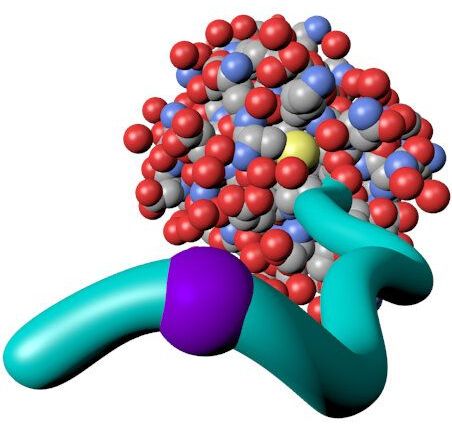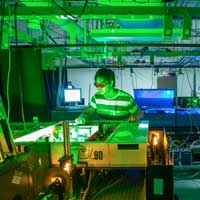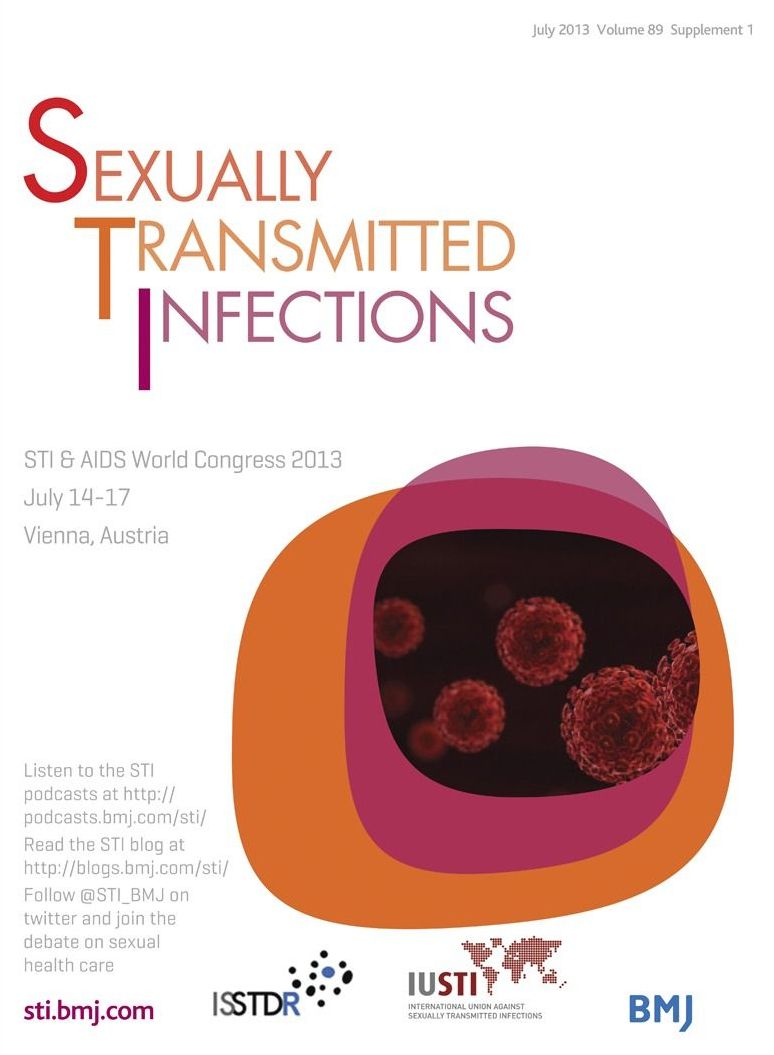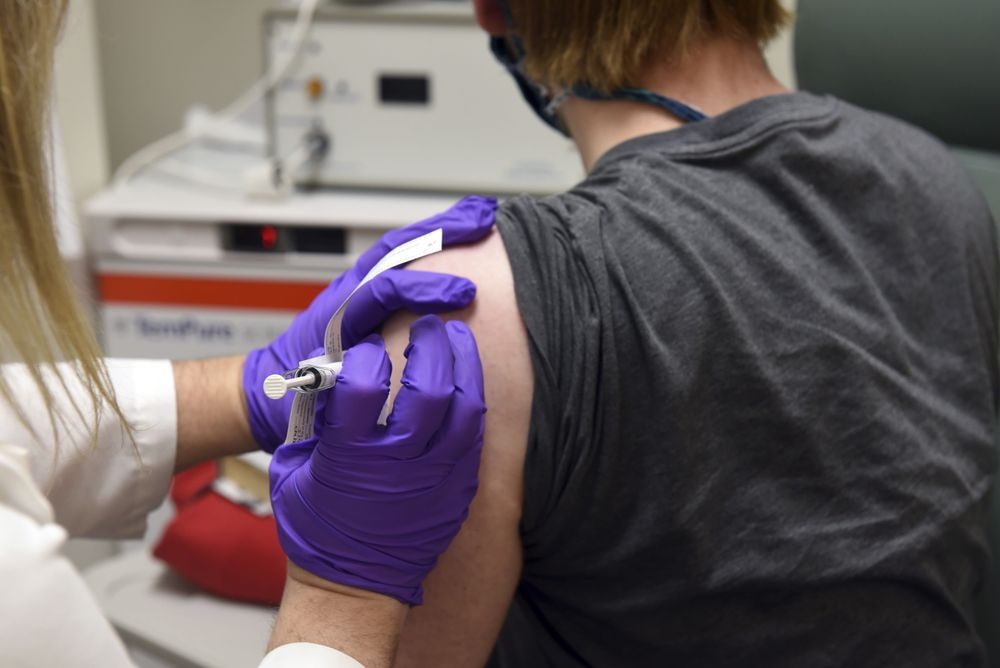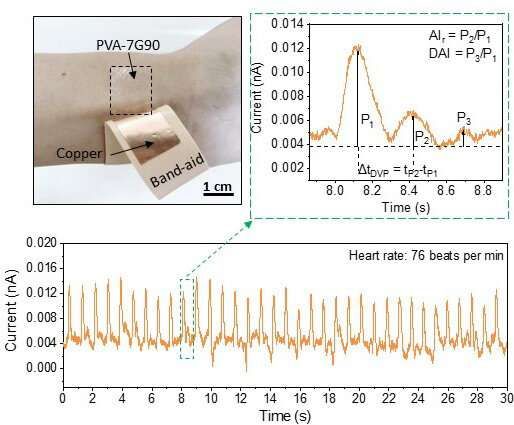Page 7223
Jul 22, 2020
Miami chemists’ breakthrough technique enables design at the interface of chemistry and biology
Posted by Genevieve Klien in categories: biological, chemistry, sustainability
A technique developed by Miami University associate professors of chemistry and biochemistry Dominik Konkolewicz and Rick Page may help enable more rapid and efficient development of new materials for use in pharmaceuticals, biofuels, and other applications.
Konkolewicz’s and Page’s technique uses nuclear magnetic resonance (NMR) technology to illuminate how proteins and synthetic polymers interact in chemical substances known as bioconjugates.
Jul 22, 2020
New antibody mix could form ‘very potent’ Covid-19 treatment, say scientists
Posted by Genevieve Klien in category: biotech/medical
Scientists at Columbia University in New York screened antibodies from 40 Covid-19 patients and identified 61 types from five individuals that effectively wiped out coronavirus. Among them were nine that displayed “exquisite potency” for neutralising the pathogen.
Tests on cells showed that the antibodies killed off the virus, while experiments with hamsters revealed that an infusion of one of the more potent antibodies protected the animals from disease. “It shut off infectious virus completely in the lung tissue of the hamsters we treated,” said David Ho, a professor of medicine at Columbia who led the research.
“We specifically isolated very potent antibodies that can be mass produced and then administered,” Ho said. “We would assume that these could be used to prevent or treat Sars-Cov-2. We’d be looking to treat early in the course of infection, particularly those at risk of developing severe disease such as the elderly and those with underlying illness.”
Jul 22, 2020
Oxygen breathes new life into solar cell research
Posted by Omuterema Akhahenda in categories: chemistry, solar power, sustainability
(Nanowerk News) Scientists in Australia and the United States have been able to ‘upconvert’ low energy light into high energy light, which can be captured by solar cells, in a new way, with oxygen the surprise secret ingredient. The results are published in Nature Photonics (“Photochemical upconversion of near-infrared light from below the silicon bandgap”).
Scientists in Australia and the United States have been able to ‘upconvert’ low energy light into high energy light, which can be captured by solar cells, in a new way, with oxygen the surprise secret ingredient.
The results are published in Nature Photonics (“Photochemical upconversion of near-infrared light from below the silicon bandgap”).
Continue reading “Oxygen breathes new life into solar cell research” »
Jul 22, 2020
P2.180 TMR5 (ZedupexTM) as a Management Therapy For Herpes Infections: Results of Preclinical Evaluations
Posted by Omuterema Akhahenda in categories: biotech/medical, innovation
Did you know there was a natural treatment for herpes “that has no treatment”. People have been treating disease for centuries. Just because something is not approved does not mean it does not work, it only means it is not approved. Even corruption can stall the approval process.
TMR5 (ZedupexTM) is a product of a Kenyan medicinal plant, prepared as a lyophilized extract and a cream. The products have been evaluated for preclinical safety and efficacy in suitable in vitro and in vivo systems of herpes infections. Herpes is a viral infection affecting over 60% of the sub-Saharan Africa young adult population. It is caused by two similar viruses, HSV-1 and HSV-2 which share 50% gene sequence homology. The infection in a major cause of genital ulcer disease, associated with increased risks of HIV acquisition and transmission. The aim is to develop TMR5 as an alternative anti-herpes agent, this being necessitated by increased resistance to available drugs and the cost of the drug of choice, acyclovir, in the region. Using the trypan blue exclusion test, plaque inhibition and viral yield reduction assays for assessment of cytotoxicity (CC50) and efficacy (EC50), and Mice and guinea pig cutaneous and genital HSV infection models respectively following oral and topical treatments, TMR5 exhibited no cytotoxicity in mammalian cell lines with a wide therapeutic index (CC50 ≥ 58.5 ± 4.6µg/ml). An EC50 of ≤ 14.7 ± 3.7µg/ml for both wild type and resistant strains of HSV was realised in plaque and viral yield assays. Oral (250 mg/kg) and topical (10% cream) administrations exhibited significant delay in onset of infections, hindered progression of infection to lethal forms with increased mean survival times and low mortality in both mice and guinea pig models. No acute toxicity has been realised at the therapeutic concentrations. TMR5 has demonstrated a high potential as an anti-herpes agent and arrangements are presently underway to evaluate its efficacy and safety in human clinical trials. A pilot production scheme supported by the National Commission for Science, Technology and Innovation (NCSTI) of Kenya has been undertaken as means of developing TMR5 as an alternative management therapy for herpes infections.
Jul 22, 2020
Apple co-founder Steve Wozniak: Motivation is more important than knowledge for achieving success
Posted by Omuterema Akhahenda in categories: futurism, internet
The most important ingredient to becoming successful is having motivation, says Apple co-founder Steve Wozniak.
“Having a purpose, motivation — motivation is worth more than knowledge,” says Wozniak says, speaking at eMERGE technology conference in Miami, Fla., Monday. Wozniak co-founded Apple with Steve Jobs in 1976.
“You can teach all the right things and that doesn’t matter. If somebody is motivated and wants to do something, wanting — it’s emotional. That’s the person that is probably going to go out and find a way to actually get it done.”
Jul 22, 2020
US scientists create ‘friction-free’ material
Posted by Quinn Sena in categories: nanotechnology, particle physics
Scientists at the US Department of Energy’s Argonne National Laboratory have found a way to use diamonds and graphene to create a new material combination that demonstrates so-called superlubricity.
Led by nanoscientist Ani Sumant of Argonne’s Center for Nanoscale Materials (CNM) and Argonne Distinguished Fellow Ali Erdemir of Argonne’s Energy Systems Division, the Argonne team combined diamond nanoparticles, small patches of graphene, and a diamond-like carbon material to create superlubricity, a highly-desirable property in which friction drops to near zero.
According to Erdemir, as the graphene patches and diamond particles rub up against a large diamond-like carbon surface, the graphene rolls itself around the diamond particle, creating something that looks like a ball bearing on the nanoscopic level.
Jul 22, 2020
U.S. agrees to pay Pfizer and BioNTech $2 billion for 100 million doses of coronavirus vaccine
Posted by Quinn Sena in categories: biotech/medical, government
The U.S. will pay Pfizer and biotech firm BioNTech $1.95 billion to produce and deliver 100 million doses of their Covid-19 vaccine if it proves safe and effective, the companies announced Wednesday.
It was the largest such deal between the government and companies racing to develop a coronavirus vaccine.
Under the agreement, the U.S. can acquire 500 million additional doses, the Department of Health and Human Services said. Germany-based BioNTech and Pfizer are jointly developing four potential vaccines.
Jul 22, 2020
Invention offers new option for monitoring heart health
Posted by Gerard Bain in categories: biotech/medical, health, nanotechnology, wearables
An invention may turn one of the most widely used materials for biomedical applications into wearable devices to help monitor heart health.
A team from Purdue University developed self-powered wearable triboelectric nanogenerators (TENGs) with polyvinyl alcohol (PVA)-based contact layers for monitoring cardiovascular health. TENGs help conserve mechanical energy and turn it into power.
The Purdue team’s work is published in the journal Advanced Materials.
Jul 22, 2020
Kenya Researchers Explore Herbal COVID-19 Cure
Posted by Omuterema Akhahenda in category: biotech/medical
Kenya has stepped up efforts to find a local treatment for COVID-19. The Kenya Medical Research Institute (KEMRI), East Africa’s leading medical research facility, is testing the efficacy of an herbal medicine known as Zedupex.
The search for both a cure and a vaccine for the coronavirus has intensified around the globe, including in Kenya, as medical researchers race to find the elusive remedy.
Dr. Festus Tolo of Kenya’s Medical Research Institute is the lead scientist tasked with finding out whether an herbal-based drug will be effective against COVID-19. Zedupex, developed in 2015 by Kenyan researchers, has been used in the treatment of herpes.

